This gallery illustrates the main article at Sistine Chapel ceiling.
| This article includes a list of references, related reading, or external links, but its sources remain unclear because it lacks inline citations. Please help improve this article by introducing more precise citations. (August 2017) (Learn how and when to remove this message) |

The Sistine Chapel ceiling, painted by Michelangelo between 1508 and 1512, is one of the most renowned artworks of the High Renaissance. Central to the ceiling decoration are nine scenes from the Book of Genesis of which The Creation of Adam is the best known, the hands of God and Adam being reproduced in countless imitations. The complex design includes several sets of individual figures, both clothed and nude, which allowed Michelangelo to fully demonstrate his skill in creating a huge variety of poses for the human figure, and have provided an enormously influential pattern book of models for other artists ever since.
Gallery
Further information: Sistine Chapel pictoral scheme The ceiling. Not shown are the lunettes around the windows, also painted by Michelangelo; see plan below.
The ceiling. Not shown are the lunettes around the windows, also painted by Michelangelo; see plan below.
 Plan of the pictorial elements of the ceiling showing the division of the narrative scenes into three themes
Plan of the pictorial elements of the ceiling showing the division of the narrative scenes into three themes
Biblical narratives
Along the centre of the ceiling are nine scenes depicting the Story of Creation, the Downfall of Humanity and the Story of Noah as told in the Book of Genesis.
-
 The First Day of Creation, God divides light from Darkness. This was the final narrative to be painted.
The First Day of Creation, God divides light from Darkness. This was the final narrative to be painted.
-
 Detail of the figure of God, which was painted by Michelangelo in a single day and may represent Michelangelo himself, painting the ceiling
Detail of the figure of God, which was painted by Michelangelo in a single day and may represent Michelangelo himself, painting the ceiling
-
 To the left, God creates the Earth and, to the right, God creates the Sun to light the day and the Moon to light the night.
To the left, God creates the Earth and, to the right, God creates the Sun to light the day and the Moon to light the night.
-
 God separating the waters from the heavens. (Context)
God separating the waters from the heavens. (Context)
-
 Separating the waters (detail)
Separating the waters (detail)
-
 The Creation of Adam shows God giving life to the first man, while Eve, the first woman, watches from beneath his cloak.
The Creation of Adam shows God giving life to the first man, while Eve, the first woman, watches from beneath his cloak.
-
 Detail of God from The Creation of Adam
Detail of God from The Creation of Adam
-
 The Creation of Eve is based on a sculpture in Bologna.
The Creation of Eve is based on a sculpture in Bologna.
-
 The Downfall of Adam and Eve and their Expulsion from the Garden of Eden. Two episodes are combined in a single frame.
The Downfall of Adam and Eve and their Expulsion from the Garden of Eden. Two episodes are combined in a single frame.
-
Drunkenness of Noah
-
 Noah's Ark floats in the background while people struggle to escape the rising water of the Great Flood.
Noah's Ark floats in the background while people struggle to escape the rising water of the Great Flood.
-
 Detail from the scene of the Great Flood
Detail from the scene of the Great Flood
-
 The sacrifice of Noah after the Flood (in context, before restoration). This picture is thought by some to represent The sacrifices of Cain and Abel.
The sacrifice of Noah after the Flood (in context, before restoration). This picture is thought by some to represent The sacrifices of Cain and Abel.
-
 Sacrifice of Noah (post-restoration. Detail)
Sacrifice of Noah (post-restoration. Detail)
Prophets and Sibyls
The Prophets of Israel and the Sibyls of the pagan world foretold the coming of the Messiah. Both have been included by Michelangelo as a sign that the Messiah (Jesus Christ) was to come not just for the Jews but also for the Gentiles (non-Jewish people).
-
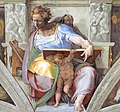 Daniel
Daniel
-
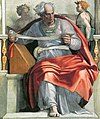 Joel
Joel
-
 Zechariah
Zechariah
-
 Jeremiah lamenting the fall of Jerusalem
Jeremiah lamenting the fall of Jerusalem
-
 Ezekiel hears the word of the Lord.
Ezekiel hears the word of the Lord.
-
 The prophet Isaiah
The prophet Isaiah
-
 The prophet Jonah
The prophet Jonah
-
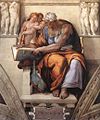 The Cumaean Sibyl
The Cumaean Sibyl
-
 The Erythraean Sibyl
The Erythraean Sibyl
-
 The Persian Sibyl
The Persian Sibyl
-
 The Delphic Sibyl
The Delphic Sibyl
-
 The Libyan Sibyl
The Libyan Sibyl
-
Detail of the Delphic Sibyl
Pendentives
The four corner pendentives show violent episodes in which the People of Israel were rescued from enemies, or from their own sinful ways.
-
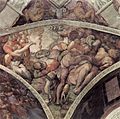 The Brazen serpent
The Brazen serpent
-
 Haman's punishment
Haman's punishment
-
 David and Goliath
David and Goliath
-
 Judith and Holofernes
Judith and Holofernes
Ancestors
The ancestors of Jesus are listed in the Biblical books of Matthew and Luke. This is the first known large painted series, although they were often shown in stained glass. See Tree of Jesse. Although each picture has a title, the characters cannot be positively identified.
-
 Achim / Eliud
Achim / Eliud
-
 Aminadab
Aminadab
-
 Asa / Jehosaphat / Joram
Asa / Jehosaphat / Joram
-
 Azor / Sadoch
Azor / Sadoch
-
 Eleazar / Mathan
Eleazar / Mathan
-
 Hezekiah / Manasseh / Amon
Hezekiah / Manasseh / Amon
-
 Jacob / Joseph
Jacob / Joseph
-
 Jesse / David / Solomon
Jesse / David / Solomon
-
 Josiah / Jechoniah / Sheatiel
Josiah / Jechoniah / Sheatiel
-
 Naason
Naason
-
 Rehoboam / Abijah
Rehoboam / Abijah
-
 Salmon / Boaz / Obed
Salmon / Boaz / Obed
-
 Uzziah / Jotham / Ahaz
Uzziah / Jotham / Ahaz
-
 Zerubbabel / Abiud / Eliakim
Zerubbabel / Abiud / Eliakim
-
 Detail of the Achim lunette
Detail of the Achim lunette
-
 Detail of the Asa, Jehosaphat and Joram lunette
Detail of the Asa, Jehosaphat and Joram lunette
-
 Detail from the Eleazar lunette
Detail from the Eleazar lunette
-
 Detail of the Ezechias lunette
Detail of the Ezechias lunette
-
 Detail of the Salmon lunette
Detail of the Salmon lunette
Spandrels
Above the windows are a series of families with young children. The children may represent particular children who are mentioned in the Bible, such as Isaac and Samuel. The composition of many of the pictures is similar to that found in depictions of the Holy Family resting on the Flight into Egypt.
-
 In the Salmon spandrel a woman is making a garment while her child looks on.
In the Salmon spandrel a woman is making a garment while her child looks on.
-
 In the Ozias spandrel a young child is attempting to breast feed from his exhausted-looking mother, who clasps a round loaf in her hand.
In the Ozias spandrel a young child is attempting to breast feed from his exhausted-looking mother, who clasps a round loaf in her hand.
-
 Jesse spandrel, before restoration
Jesse spandrel, before restoration
-
 Jesse spandrel, after restoration. In this spandrel, a young woman who may represent the Virgin Mary gazes out with a prophetic expression. The details of her eyes were removed in the recent restoration.
Jesse spandrel, after restoration. In this spandrel, a young woman who may represent the Virgin Mary gazes out with a prophetic expression. The details of her eyes were removed in the recent restoration.
-
 The Ezechias spandrel shows a small child gazing out of the picture.
The Ezechias spandrel shows a small child gazing out of the picture.
Ignudi
The Ignudi that surround the narrative scenes may show the perfection of Humanity, or may represent angels. They were often imitated by other artists.
- The Separating the Waters group
-
 The great muscularity of the lower back of this figure suggests that he was a stonemason.
The great muscularity of the lower back of this figure suggests that he was a stonemason.
-

-

- The First Day of Creation group
-
 Above Jeremiah. This figure is one of the most reproduced on the ceiling.
Above Jeremiah. This figure is one of the most reproduced on the ceiling.
-
 Above Libyan Sibyl
Above Libyan Sibyl
Shields
There are 10 shields (medallions) representing violent episodes in the history of Israel.
-
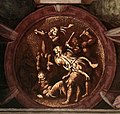 'The Death of Uriah'
'The Death of Uriah'
-
 Detail of 'The Idol of Baal'
Detail of 'The Idol of Baal'
-
 'Joab sneaking up on Abner to murder him' or 'Death of Razis' or 'Suicide of Razis'
'Joab sneaking up on Abner to murder him' or 'Death of Razis' or 'Suicide of Razis'
See also
References
- Hirst 1994, p. 64.
- Panyard 2013, p. 10.
- Zöllner & Thoenes 2022, p. 162.
Sources
- Massimo Giacometti, The Sistine Chapel, a collection of essays on aspects of the chapel, its decoration and the restoration of Michelangelo's frescoes, by Carlo Pietrangeli, André Chastel, John Shearman, John O'Malley S.J., Pierluigi de Vecchi, Michael Hirst, Fabrizio Mancinelli, Gianluigi Colallucci, and Franco Bernabei. 1984, Harmony Books ISBN 0-517-56274-X
- Gabriele Bartz and Eberhard König, Michelangelo, 1998, Könemann, ISBN 3-8290-0253-X
- Hirst, Michael (1994). The Sistine Chapel: A Glorious Restoration. ISBN 978-0810938403.
- Panyard, Christine M. (2013). The Sistine Chapel: a Biblical tour. ISBN 978-0-8091-0593-9.
- Zöllner, Frank; Thoenes, Christof (2022). Michelangelo. ISBN 978-3-8365-3716-2.
External links
| Michelangelo | |||||||||||||||||||
|---|---|---|---|---|---|---|---|---|---|---|---|---|---|---|---|---|---|---|---|
| |||||||||||||||||||
| |||||||||||||||||||
| |||||||||||||||||||
| |||||||||||||||||||
| Art of the Sistine Chapel | |||||||
|---|---|---|---|---|---|---|---|
| Life of Moses |  | ||||||
| Life of Christ | |||||||
| Ceiling (Gallery) |
| ||||||
| Altar wall | |||||||
| Tapestries | |||||||
| Related | |||||||








